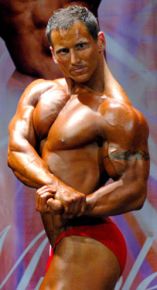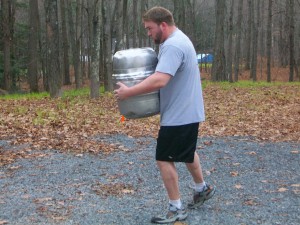Great Finisher for Bench Day - Steel Bending
by Jedd Johnson, CSCS author of Ultimate Forearm Training

There are hundreds of exercises that have been defined for increasing upper body and arm strength for the bench press. These involve using bars, benches, dumbbells, cable machines, and many other types of training tools commonly found in commercial, warehouse, and home gyms.
However, for as many exercises that are available to us, sometimes it is still fun to try something new every once in a while.
Maybe the gym you go to doesn't have much equipment and your selection is limited.
Maybe you are limited to what you can do because you don't have a training partner that you can depend on to help you with heavier loads.

Maybe you are short on cash and can't add a large, expensive piece of equipment to your home gym right now.
Whether any of these conditions or others are limiting the array of exercises and equipment you can use on bench day, chances are everyone is looking for something new that can break the monotony of your workout.
So, I've got something cool for you to try out - Steel Bending.
The type of steel bending I most often take part in is short, unbraced bending. This involves wrapping 8-inch lengths (or shorter) of steel stock, nails, bolts, screws, and other steel objects in towels, suede leather, cordura, or other protective material and bending it into a U-shape without propping it against the belly, thigh or knee.
Short, non-braced bending is what I feel serious benchers would benefit most from because it recruits the largest amount of sheer pec, delt, and lat power while also harnessing the strength of the stabilizers and synergists in the back, upper arms and forearms.
While longer, braced bends also involve serious recruitment from a broad range of muscles, I prefer shorter bends.
Where to Get Steel
The perfect way to start bending is to go raid the hardware store of nails and bolts.
Take a tape measurer with you and look for steel that is 3/16 or 1/4 inch in diameter. These are good thicknesses to start with when beginning.
Nails: Look for 40D and 60D nails. They have about a 1/4 inch diameter. Generally these are in the carousel-looking racks that have multiple tiers and spin around. They will be marked with either 40D and 60D or 40 penny and 60 penny on the individual labels.
Bolts: Bolts are plentiful at hardware stores. With your tape measurer, look for bolts that are between 5 and 7 inches long, and stay about 1/4 inch thick. Generally, the longer the bolt, the easier the bend and the shorter, the tougher. Bolt difficulty varies by the manufacturer and exactly what kind of bolt it is. Grade bolts or cap screws are usually the most consistent. Common examples include Grade 2, Grade 5, and Grade 8. The higher the grade, the tougher the bend. Also, if the bolt is threaded in the center, it will be easier to bend than non-threaded bolts.
Wrapping
There are many materials that can be used for bending.
Towels: I started out using towels. These are good for padding, but after a few bends, the towel will rip or give way to the tip of the steel, so I quickly stopped using them.
Cordura: This is a special nylon fabric originally invented by DuPont. It can be purchased at many on-line sites, as well as the large chain fabric stores. It is very strong and rarely succumbs to the point on the steel, but it is not impenetrable. It is also not very good at padding the hands.
Denim: An old pair of pants can be cut up for a very strong type of bending wrap material. Denim is very resilient, but it also bunches up and slides around on the steel.
Suede Leather: This is the gold standard of steel bending, especially for hitting heavy steel and getting the upper body involved. It is available on-line at many sites and scraps can be gotten from leather shops
Technique
For the benefit of upper body training, specifically the pecs, lats and delts, the Double Overhand technique is the best way to go, although there are many other ways to bend short steel.
To do the Double Overhand technique, first wrap the steel and then put your hands out on the ends. Bring the steel up as high as you can and push on the ends of it using your wrist and upper body strength. Keep pushing until the ends of the steel are within two inches of each other. You may have to readjust your grip from time to time to make this happen efficiently.
Training Results
Try one bend and you will see just how taxing steel bending can be. You will feel it in your hands, forearms and especially in your torso. When doing a tough bend, it will literally feel like you are pressing with your pecs and delts as hard as you possibly can, yet no movement takes place in the steel at all. This is great for peak contraction in the muscle as well as triggering improved endurance.
 On top of the muscular effects, many people start sweating profusely during a bend. There is so much tension created during a bend, that it increases blood circulation and body temperature and your body compensates by sweating.
On top of the muscular effects, many people start sweating profusely during a bend. There is so much tension created during a bend, that it increases blood circulation and body temperature and your body compensates by sweating.
Another benefit of steel bending is cardiovascular. Because of all the high intensity muscular activity, the blood is pumped throughout the body at a faster rate and you have to start breathing heavier in order to feed your muscles the oxygen they need. Many benders start out struggling to push for 30 seconds because they just don't have that kind of endurance. Five solid bends give you a more intense workout than 30 minutes on a treadmill.
Finally, steel bending will make you mentally tough. Steel bending sounds intimidating at first, but bending steel makes you confident and gives you a rush. When you smash through that first nail, you're going to want another one. Many guys get addicted to steel bending after just a couple of workouts.
As you can see, bending is an awesome way to get a lot of work done in a short time to strengthen the main muscles involved in bench pressing, as well as all the ancillary muscles, plus the added benefits of getting the other physical and mental results.
If you want even more information, the absolute best resource for learning how to bend steel safely is my Bending eBook. I'll show you how to ramp-up from easy steel to some of the toughest on the planet, as well as showing you dozens of exercises for building up Grip and Torso Strength you can use to not only ravage steel like a monster, but also increase you MAX on the bench press, which is your primary long-term goal.
Diesel Nail Bending eBook

More Articles By Jedd Johnson
Return to the Workout Articles Archive
|